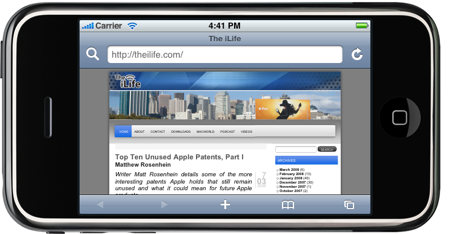iPhone 2.0
7 03 2008
This June, iPhone’s going 2.0. Apple is adding a host of much-clamored-for features (mostly for enterprise users) in addition to, finally, official support for third-party software.
As with the Apple TV, the early adopters (all four million of them) won’t be left out of the fun — iPhone 2.0 is coming as a free software update and includes licensed ActiveSync support, 802.1x networking (a must at many colleges and businesses), and the App Store, where developers can list their programs at prices from $0 up. The message behind 2.0 is clear: iPhone is being evicted from its niche. Apple aims for it to be the mobile communicator of the future, King Smartphone, handed out by the thousands at the world’s largest corporations and purchased by any individual with the desire to stay connected.
Ever since it became clear that iPhone runs OS X, developers have been willing to try almost anything to write applications for it. Ignored was Steve Jobs’ insistence that sticking to web apps would provide sufficient development freedom while keeping the platform — and AT&T’s network — safe and stable. A toolchain was independently developed, an iPhone-based installer and update manager was put together, and development flourished.
The announcement that Apple would be releasing its own SDK, the same one that had been used internally to create the built-in apps, was welcome — if not a bit late. But, with full 3D graphics, the ability to remotely debug programs and record every detail of their performance, and the same Xcode programming environment that Mac devs know and love, what Apple revealed yesterday was impressive enough to establish iPhone as the most advanced mobile device platform out there.
The game developers which Apple brought in to test out the platform (for just two weeks!) had to treat it more like a gaming console than a phone, and Sega had to fly in an artist to revise graphics that, unexpectedly, weren’t of high enough quality. In the same two weeks, an AOL dev who had never worked on a Mac had produced an impressive, full-featured instant messaging client.
Everyone else has until June to produce whatever applications they can imagine before the App Store goes live. The turnout is going to be impressive.
Apple’s second, less-expected announcement is the addition of a host of enterprise features to iPhone. Email, calendars, and contacts will be kept synchronized in real-time directly with companies’ Exchange servers, and iPhones will be set up en masse through a set of specialized tools. Companies will be able to enforce passcode locks on employees’ iPhones and even remotely erase them, instantly, if they should be lost or stolen.
That featureset was, really, all that has until now stopped companies from adopting iPhone instead of Blackberry, Windows Mobile, or Palm. Apple has let Nike and Disney field test iPhone 2.0, and gave the sense that it was a great success.
Who knows? Maybe it wasn’t Apple’s computers that were destined to dominate the world, after all.


 RSS 2.0
RSS 2.0
Nice article, man! Looking forward to more in the future!!
Hey Sidney,
I have a very specific and unrelated question for you. I have been too busy with school to bother getting an iPhone working in Canada. But with the new SDK will my wait be over, will the developer be able to create applications that allow the iPhone to be used in Canada. To my understanding this SDK has essentially ‘Unlocked’ the iPhone. Is this correct? Again I myself have not had time to research.
Thanks,
Daniel Lodewyk
Daniel-
I haven’t made it through all that much of Apple’s new documentation, but I get the sense that the official SDK will be useless to unlocking efforts.
The unofficial SDK that’s been in use up to now is perfectly fine for unlocking iPhones — the challenge is in finding exploits and creating the actual unlocks, not in distributing and applying them.
The official SDK is great for “rich” applications like games and is much better integrated into iPhone OS, but is VERY restricted in interacting directly with hardware — apps aren’t even allowed to communicate through the dock connector, let alone reprogram the phone’s baseband!
Not to mention that Apple will be reviewing each submission to the App Store before it goes live, and Steve Jobs confirmed with press that unlocking apps won’t be let in.
While we can’t recommend violating any license or carrier agreements here at The iLife, let me just note that every iPhone out there at the moment is unlockable — the Dev Team’s efforts haven’t been hindered a bit by lack of an official SDK.
Thanks Sidney. I was under a wrong impression. I suppose the iPod Touch is my best way to go, then maybe I will have to buy an iPhone at a later date. We Canadians have the worst luck with Apple related things. The iTunes store, Movie rentals, and now the iPhone… it is unfortunate.
Thanks,
Daniel Lodewyk